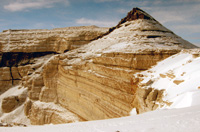
"Time is what stops everything happening all at once"*
| ESS 461 home |
| Information |
| Lecture notes |
| Labs |
| Research project |
| Term papers |
| Reading |
| Web resources |
| Footnotes |
| FAQ |



ESS 461 Reading
Textbooks
Here are some thoughts to follow up what's on the information page. Most are in the library, or can be found second-hand on the web. Try Powell's Books of Portland, abebooks, or alibris [Disclaimer: not a paid advert], or the University Bookstore.
Probably, the most comprehensive text is: Faure, G. and Mensing, T., Isotopes: Principles and Applications This is the third edition of Faure's original Principles of Isotope Geology. Copies of each edition are on reserve at Odegaard. The Natural Sciences Library also has a couple of copies of the first (1977) edition, which covers the basics. Beware, however, that much has happened in the field since 1977. This edition pre-dates important developments such as Sm-Nd geochemistry, U-series dating by mass spectrometry, terrestrial cosmogenic isotopes, and calibration of the Carbon-14 timescale.
For a comprehensive treatment of geological dating methods based on very long-lived isotopes, try Dalrymple, G. Brent; The Age of the Earth. This one focuses on the age of the Earth and solar system, and events in the deep geologic past. To do so it covers the fundamentals of long-lived isotopic dating systems (K-Ar/Ar-Ar, U-Pb, Sm-Nd and Rb-Sr) very thoroughly. It's written with almost legal precision. In fact, the author says that it grew from his work assembling evidence for court cases contesting the teaching of creationism in the 1980s.
Dickin, A.P. Radiogenic Isotope Geology. Cambridge University Press, 1997: A more recent text, unfortunately not in the UW library. It's aimed at a broader course on isotope geochemistry, but the geochronology sections are quite thorough.
More specific reading, by topic
History and background
For an excellent short history of geochronology, I recommend the introductory chapters of Dalrymple's book, listed above.
A few years ago England, Molnar and Richter published an excellent and highly readable re-evaluation of Kelvin's calculations concerning heat flow, secular cooling and the age of the Earth. You can find it on the GSA website. I've also placed a copy in the class download directory (UW access only).Note that this doesn't address Kelvin's parallel calculation of the age of the Sun, which produced a similar, and equally erroneous, estimate to his calculation for the Earth. Incidentally, the modern helioseismic estimate of age of the Sun is 4.57 +/- 0.11 Gyr, almost exactly equal to the best estimates from meteorites. If you're interested in the difficulties that scientists like Rutherford, Joly, Boltwood and Holmes faced in trying to date rocks before the physics of radioactivity was fully pieced together, here are some interesting papers from Google Scholar, the open archives of The Royal Society (try searching under 'Newton, I' or 'Lyell, C') and the American Journal of Science: Rutherford (1906): Pages from his book 'Radioactive Transformations' describing an age estimate for a sample of fergusonite, a rare U-bearing from Norway. The original discovery of He in fergusonite was published a decade earlier by Ramsay and Travers (1897), who, at the time, did not realise its radiogenic origin. In fact, previous analyses showing that an inert gas was expelled from U- and Th-bearing minerals on heating, identified the gas as nitrogen. In 1905 Bertram Boltwood used chemical analyses of uranium-rich minerals, in which he noticed the "frequent and almost invariable occurrence of Pb", to identify this element as the ultimate decay product of uranium. By 1911, Arthur Holmes had recognized the potential of U-Pb dating. His paper is a landmark in geochronology, touching on all the important ideas and assumptions that underlie modern methods. Nuclear physics and chemistry
Friedlander, G., Kennedy, J.W., Macias, E.S. and Miller, J.M. Nuclear and Radiochemistry. Wiley. 1981. This book has (almost) all the answers. Very comprehensive and authoritative; it goes into far more detail than we need for this class. Particularly good on laboratory and experimental methods.
Carbon-14, luminescence and Quaternary dating methods
Taylor, R.E. and Aitken, M.J. (eds.) Chronometric Dating in Archaeology. Plenum Press. 1997. Available in the QRC library.Taylor, R.E. Radiocarbon Dating. An Archaeological Perspective. Academic Press. 1987. Available in the QRC library. The full scientific report on dating the Shroud of Turin: Stuiver, M. and Polach, H.A. (1977) Discussion: Reporting of 14C data. Radiocarbon 19, 355-363. Aitken, M.J. (1998) An introduction to optical dating. Oxford Science Publications. Oxford. Imbrie, J. & Imbrie K.P. Ice ages: solving the mystery. Harvard University Press, 1986. Uranium series dating
Ivanovich, M. and Harmon, R.S. Uranium-series disequilibrium: applications to earth, marine, and environmental sciences. Clarendon Press, Oxford. 1992. Available from the Chemistry library. Thermochronology
McDougall, I. & Harrison, T.M. Geochronology and thermochronology by the 40Ar/39Ar method. Oxford University Press, Oxford. 1988. Radioisotope tracers
Broecker, W.S. & Peng, T.-H. Tracers in the sea. Lamont-Doherty Geological Observatory, Columbia University, 1982.
